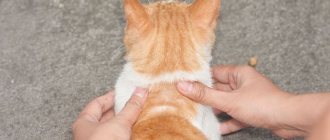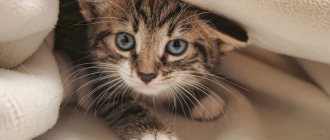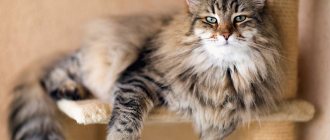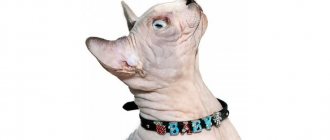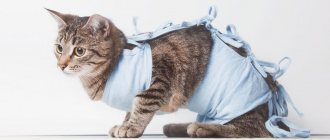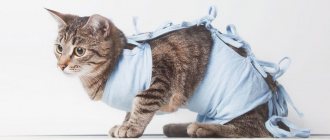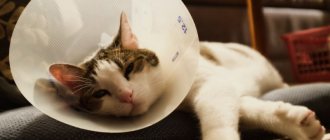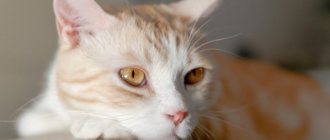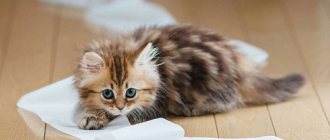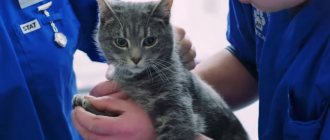Types of cat sterilization operations
As a rule, this is an abdominal operation, during which the cat’s uterus is removed along with the ovaries through a side incision of no more than 2 cm. The suture is tightened with biofilament, which resolves after a few months. Within 2-3 days after the operation, the cat returns to an active life; the operation leaves no mark on its psyche and does not affect its mobility.
Laparoscopic method and pregnancy
Also, to remove the uterus and ovaries, a laparoscopic method is used, in which only two punctures are made in the abdominal cavity. The punctures are sealed with special glue. After such an operation, the animal recovers very quickly. The disadvantage of this operation is its high cost.
Other methods
In the recent past they have been used
- tubal occlusion (tubal ligation);
- hysterectomy (removal of the uterus while preserving the ovaries);
- oophorectomy (removal of the ovaries without removal of the uterus);
- medicinal sterilization (chemical, when an implant with a substance that blocks reproductive functions is inserted under the skin);
- radiation sterilization (irradiation of the uterus).
But incomplete sterilization, firstly, is pointless, and secondly, it is fraught with the development of purulent infections and inflammations, and the last two methods are very toxic and carry a great risk to the life of the cat. Therefore, all of them are almost never used in veterinary practice.
1) Miscarriage in cats with resorption of the fetus(es) in early pregnancy
It occurs asymptomatically and does not pose a danger to the cat. The fetuses may be partially reabsorbed; for non-resorbed fetuses, pregnancy will proceed as usual.
• Genetic characteristics of the cat breed (homozygous embryos of Manx, Cymric and Munchkin inevitably dissolve in the womb)
• Inbreeding (inbreeding)
2) Miscarriage in cats due to intrauterine fetal death
Intrauterine fetal death is possible at any stage of a cat's pregnancy.
The fetuses die in utero, are rejected by the cat and expelled entirely or in parts along with the placenta. In this case, a miscarriage is accompanied by bleeding, discharge of blood, pus and mucus from the vulva.
Such a miscarriage in a cat may go unnoticed by its owners, since the cat often licks itself and eats the fruits and placenta.
Indications and contraindications for surgery
Sterilization by ovariohysterectomy, as stated earlier, is preferable to oophorectomy. But still, in some cases, or at the request of the owner, only the ovaries are removed, while the uterus is preserved. This is due to dramatic changes in behavior and the absence of the risk of developing genital diseases. The main indications for sterilization of cats are:
- preventing unwanted pregnancies in cats;
- cessation of sexual hunting and related complications;
- prevention and prevention of the development of inflammatory processes in the mammary glands;
- purulent processes in the reproductive organs of the animal;
- chronic non-bearing of kittens during pregnancy.
There are also a number of contraindications that should be taken into account before surgery. The main ones are:
- period of sexual hunting;
- complication of the diestrus phase;
- weakened animal body;
- chronic diseases of the cardiovascular system.
Carrying out planned sterilization of a cat helps to exclude the development of tumor processes in the uterus and appendages, as well as the mammary glands. In addition, after eliminating sexual heat, the life expectancy of cats increases by an average of 4-5 years.
Note! Timely sterilization of yard cats that have free access to the street can significantly reduce the population of homeless and stray animals.
There is also a negative side to oophorectomy or another type of sterilization - severe stress for the pet. This is due to general anesthesia and the rehabilitation period. An important drawback is a decrease in metabolic processes in the body, which, with an incorrectly selected and adjusted diet, leads to serious disorders in the cat’s body - diabetes, urolithiasis and allergic manifestations. A greater number of complications after surgery are associated with improper postoperative care and improper lifestyle of the pet.
How to recognize pyometra
Pyometra develops rapidly. The owner observes the first symptoms 1-2 months after the end of estrus, during which a favorable environment for the proliferation of bacteria is maintained in the uterus.
Symptoms of pyometra depend on the form of the disease. When the cervix is open, the cat develops strong purulent vaginal discharge, and the animal licks itself frequently and diligently. In the places where the cat lay, wet brown spots are visible. The animal refuses food, drinks more, and its body temperature rises.
When the cervix is closed, the disease is more pronounced, since pus accumulates in the horns of the uterus and in the cavity itself and does not come out. In this case, the cat exhibits the following symptoms:
- there is no discharge or only a slight smear;
- the abdomen increases in size, becomes painful and tight;
- the cat has a fever;
- the animal drinks a lot and refuses food;
- in some cases there is diarrhea;
- the cat urinates more often;
- the animal becomes apathetic, breathing is heavy, and there is no reaction to external stimuli.
Symptoms
Signs of pyometra can be noticed approximately 2-4 weeks after estrus, and most often the disease begins acutely, with pronounced symptoms.
The main manifestations of the pathology are as follows:
- discharge from the loop of a brownish or cloudy white color with a thick consistency and unpleasant odor (occurs only when the cervix is open);
- lack of appetite, accompanied by severe thirst, vomiting, diarrhea;
- frequent urination;
- enlargement of the abdomen, uterus and genital organs, which can be noticed during visual inspection and palpation;
- deterioration in general health, fever, apathy or increased aggression.
Sometimes the disease develops so rapidly that the animal can die in a matter of days - the volume of purulent exudate reaches a liter in just a day, as a result of which the walls of the uterus rupture due to increased pressure, and fluid fills the abdominal cavity.
When the cervix is closed, the course of the disease can be hidden - the cat looks lethargic and apathetic, avoids active games and loses appetite, the coat becomes dull and disheveled. She can lick her belly often and for a long time, and when she tries to palpate or simply touch it, she shows great anxiety. If any of the above symptoms develop, you should immediately take the animal to a veterinary clinic, otherwise it may die.
To make a diagnosis of pyometra, the doctor performs a visual examination and palpation of the abdomen, after which he prescribes an ultrasound examination and blood tests. Ultrasound allows you to assess the size and extent of damage to the uterus - with the development of the pathological process, the organ greatly enlarges, its walls thicken, an accumulation of pus is observed in the cavity, and cysts and neoplasms appear on the surface. Blood tests reveal elevated levels of leukocytes, urea and protein, as well as a shift in the leukocyte formula to the left.
To diagnose purulent inflammation of the uterus, an ultrasound examination is performed on the animal. Using an ultrasound, the doctor examines the condition of the affected organ; with pyometra, the uterus becomes greatly enlarged, pus accumulates in it, cysts are visible on the surface, and the walls thicken.
The veterinarian will take the cat's blood for analysis. Hyperproteinemia, leukocytosis, hyperglobulemia, a shift to the left in the leukocyte formula, as well as an increase in urea (up to 300 mg) indicate the development of pyometra. An increased amount of protein is found in the urine (proteinuria).
Preparation for ovariohysterectomy surgery
Proper preparation before surgery will help the animal recover from anesthesia as quickly as possible after surgery with minimal health risks. In addition, with proper preparation of the animal before planned sterilization, the rehabilitation period is much easier and already on the 3rd day the pet feels normal, begins to eat and return to its previous lifestyle.
Before ovariohysterectomy, the owner must prepare the animal in advance by giving the pet all the necessary vaccinations and antiparasitic treatments. Next, when visiting a veterinary clinic, the doctor must do a full clinical and diagnostic examination of the animal. This will allow timely identification of possible chronic diseases of internal organs. It is also necessary to take blood and urine tests, undergo echocardiography and ultrasound.
Note! The vast majority of complications after sterilization are associated with recovery from anesthesia. The animal does not want to eat normally, tries not to contact the owner and other animals, the cat’s heart rate and body thermoregulation are disturbed - all these are consequences of the animal’s weakened body.
After all the studies have been carried out and permission for sterilization is completed, a date for the planned operation is set.
An important condition before strip surgery is a fasting diet. The pet must be kept without food for 12 hours before surgery. You can give him something to drink, but 3 hours before anesthesia, you shouldn’t give him water. This ban is associated with the possibility of developing aspiration pneumonia.
During anesthesia, the animal may begin to vomit and if there is food or water in the stomach, the contents may enter the respiratory system along the ascending route.
Treatment with folk remedies
Treatment tactics for pyometra in cats depend on the clinical course of the disease and the degree of organ damage. Most often, doctors insist on sterilizing the animal (complete removal of the uterus and ovaries), but if the pathological process was identified in the early stages, drug therapy is possible.
Conservative treatment
The goal of conservative treatment of pyometra is to cleanse the uterine cavity of pus and pathogenic bacteria, restore the functioning of the reproductive system and relieve general intoxication of the body. The basis of treatment for the disease is antibiotics - ceftriaxone, amoxicillin, brulamycin, etc., which are most often administered intramuscularly and subcutaneously.
To remove purulent exudate, special drugs are used that cause contractions of the uterus (oxytocin, prostaglandin), but the dosage should be selected very carefully, otherwise rupture of the walls of the organ and rapid death are possible. To improve the functioning of the immune system, the cat is prescribed immunostimulating agents and vitamin therapy.
Relapses can develop during the next estrus, so even with effective drug therapy, owners are advised to consider sterilizing their pet.
Traditional therapy for the development of pyometra in cats is ineffective and can lead to serious health consequences. Products with anti-inflammatory, antibacterial and regenerating effects (infusions and decoctions of chamomile, calendula, nettle) can only be used in combination with medications prescribed by a doctor, after the acute symptoms of the disease have been relieved.
Surgery and postoperative period
Surgery is the most effective treatment for pyometra in cats. The operation allows you to completely stop the pathological process, eliminate the threat to the animal’s life and the possibility of relapse of the disease. The cat is given general anesthesia, after which the surgeon carefully removes the reproductive organs - the uterus and ovaries. The main disadvantage of surgery is that after such treatment the cat will no longer be able to give birth to offspring.
To prevent postoperative complications and speed up the regeneration process, a cat that has undergone hysterectomy requires careful care:
- Immediately after the operation, the cat is put on a special blanket, which cannot be removed, otherwise the animal may damage the stitches.
- The surgical site is regularly treated with hydrogen peroxide or other antiseptic drugs. To prevent complications, the animal is prescribed antibiotics, which must be given in accordance with the doctor’s recommendations.
- In the first 24 hours after treatment, the cat should not be fed, but it should receive sufficient water.
- During the postoperative period, the animal is fed with ground or semi-liquid food - special pates, porridges or broths with meat puree.
It is important to regularly inspect the surgical site and monitor the general condition of the pet, and immediately report any pathological changes to the veterinarian.
Pyometra is treated in three ways: surgically removing the uterus and ovaries, prescribing medication, or using folk remedies. Surgery is the most effective treatment for this disease.
It is not advisable to treat pyometra with folk remedies. Taking decoctions and infusions will help relieve inflammatory processes, but such measures are only auxiliary. Nettle infusion will reduce bleeding, and calendula and chamomile will accelerate the healing of affected tissues. The use of folk remedies is allowed only in combination with surgical or drug treatment.
Typically, cat owners, especially beginners, are interested in how the animal will behave after sterilization. The fact is that the operation itself lasts no more than 15 minutes, but as a result, the animal will lose the ability to bear offspring.
This is due to the fact that it is necessary to wait until the animal’s mammary glands return to normal. Normally this occurs within 2-3 weeks. Only after this can the animal be sterilized. If the operation is performed earlier, this will negatively affect the cat’s health.
One of the concerns that cat owners usually express is the fear that the animal may suddenly gain weight after surgery. To prevent this from happening, it will be necessary to limit the animal’s diet and feed it strictly according to a schedule. In this case, it is necessary to use low-calorie feed for feeding. If you follow these rules, your cat will not get fat.
We should also talk about the effect of sterilization on the animal’s instincts. So, for example, many cat owners fear that a sterilized animal will stop catching mice. This is usually associated with the fact that hormones exacerbate the hunting instinct, and when the ovaries are cut out, they are produced in small quantities, and the cat stops catching mice. It is a myth.
It’s worth dispelling another myth. It consists in the fact that sterilized animals do not mark. There is some truth in this statement, since such a cat has less need to mark its territory, and education plays a big role here. If you have not taught the animal to be clean from the very beginning, no amount of surgery will help you do this. Therefore, even at a tender age, teach the kitten to go to the litter box on time. This will give you greater effect than any other surgery.
In any case, remember that if you want to have offspring from your cat, it is better to give her medications that suppress sexual desire from time to time, since sterilization surgery is irreversible. As for those animals that are of no value in the tribal sphere, they should definitely be operated on, since this will not only get rid of various inconveniences, but will also extend the life of your animal by 2-3 years.
After surgery to remove the uterus, the animal needs care. It includes the following activities:
- put a post-operative blanket on the cat so that it does not chew or lick the stitches;
- inspect the seam every day, if there is redness and inflammation, show the animal to the veterinarian;
- on the first day the cat may not eat, but water should be freely available;
- after the operation, the cat should be fed soft and semi-liquid food; a special veterinary diet (pates) or chicken broth with chopped meat is suitable for this;
- Monitor the cat’s condition, and if there is any deterioration, show the animal to a veterinarian.
Before castration, you need to make sure that the cat is healthy. All routine vaccinations are done at least 3-4 weeks before surgery. You may need a general blood test, urine test, ultrasound of internal organs, or a cardiogram. If a pregnant cat is sterilized for medical reasons, most likely, an additional examination by a veterinarian will not be prescribed. Antiparasitic and anthelmintic treatment is carried out in advance.
After examination and receipt of all test and diagnostic results, the veterinarian sets a date for surgery. Before doing this, it is advisable to trim the animal’s claws so that the pet does not scratch the seam. The operation is performed on an empty stomach - the animal is not fed 12-16 hours before surgery. There is no water for three hours. This is done so that after recovery from anesthesia the pet does not start vomiting.
The operation can be performed at home or in a clinic. If the cat is pregnant - only in a clinic setting, so that the veterinarian has the opportunity to quickly respond to possible complications.
The animal's belly area is shaved (you can do this at home), the drug is injected intravenously, and the cat is put under anesthesia. Afterwards, an incision is made in the lower abdomen (2-2.5 cm, more in case of pregnancy), and the reproductive organs are removed. Then a suture is placed, most often using self-absorbable suture material. A protective blanket or bandage is put on the cat to protect the seam from licking.
How the animal will recover after surgery depends on the individual characteristics of the pet. If the cat was pregnant, the road to recovery may be delayed due to severe blood loss. In any case, after anesthesia the animal will be lethargic and apathetic. When walking, the cat may fall or try to jump higher.
Monitoring your general condition in the postoperative period
Sterilizing a cat takes about an hour. The cat requires careful
after surgery to remove the uterus. For several hours after surgery, the animal may be lethargic, sleepy, and lack any interest. Symptoms of disorientation and unsteadiness of gait appear. Nausea and vomiting may occur.
At home, after the hospital, place the cat in a previously prepared warm place and cover it with a blanket. After undergoing anesthesia, the ability to maintain temperature is impaired. Body temperature decreases by 2-3ºС. After a few hours, place a bowl of water nearby.
If the outcome of the operation to remove the uterus is favorable, the pet will begin to eat the next day. It is important to review your cat's diet after hysterectomy. You can feed your cat within 24 hours. Give your cat only dietary food in the amount of a third of its normal diet. Provide additional administration of the vitamin-mineral complex. If she refuses to eat for more than 3 days after surgery, be sure to consult a doctor.
The doctor prescribes antibiotic injections. Owners can give 2 injections themselves or bring the animal to the clinic. They are administered subcutaneously.
Taking medications
Taking medications is used in cases where it is necessary to preserve the ability to bear offspring. This method gives the desired effect only in 15% of cases. Treatment with medications helps only at the first stage of the development of the disease; moreover, there is a high risk of relapse after recovery
The purpose of this treatment is to remove purulent masses from the uterus, get rid of bacteria and increase the animal’s immunity. Veterinarians prescribe the following medications:
- oxytocin or prostaglandin - these drugs cause contractions of the uterus and promote the release of pus, but they are used very carefully, since the wrong dosage causes uterine rupture and leads to death;
- Brullomycin - the drug is administered intramuscularly three times a day, 0.2-0.3 ml, the course of treatment is 2.5-3 weeks;
- cloprostenol - administered subcutaneously for 3 days at a dosage of 5 μg of the drug per 5 kg of weight;
- amoxicillin - combined with cloprostenol, the dosage is calculated as follows: per 1 kg of weight, 20 mg of the drug, injected into the muscle for a week;
- ceftriaxone is an antibiotic that is diluted in 5 ml of novocaine, administered intramuscularly, the dosage is selected by a veterinarian;
- To increase immunity, the cat is prescribed immunofan and ribotan, and fortified supplements are included in the diet.
If the uterus has been removed, the postoperative period is of great importance
Removal of the uterus is a very difficult process, since it is a rather serious intrusion into the normal functioning of the female body. The consequences that may occur after such an operation are very different, but you need to know that the removal of the uterus, the postoperative period after which will be long and difficult. Recovery after hysterectomy is divided into 2 stages: early and late.
The early period after removal of the uterus takes from 5-12 days, the period depends on important factors. During this period, it is worth considering the following points:
Pain relief in the first 5 days after surgery. The reason is that it has already been proven that severe pain after surgery to remove the uterus significantly slows down the healing process. If the patient suffers from sharp or nagging pain, she definitely needs to go to the clinic for a good analgesic;
Required systematic physical activity. Doctors insist that in the first days after removal of the uterus it is necessary to get up and move, as this is what helps to avoid major postoperative complications.
The immobile state of the patient can lead to problems with blood circulation and the appearance of blood clots in large veins in the legs, and even in the lungs.
Even if the hysterectomy was successful, the postoperative period requires the prescription of antibiotics, and sometimes general restorative or symptomatic medications. The seams are treated and disinfected with solutions every day.
In the early postoperative period, it is important to remember a serious complication - bleeding. It can be either external or internal, and it is the removal of the uterus, the postoperative period of which is long, that has a huge impact and increases the risk. Therefore, if negative changes in general well-being are detected, either it is doubtful
- home
- >
- Cats
- >
- Cat health
- >
- How is a cat's hysterectomy performed?
Disease prevention
The most effective way to prevent pyometra is planned sterilization of the animal, which is recommended after 7–8 months of age. If a cat is of breeding value, the owner must comply with the following rules:
- do not abuse drugs to suppress estrus (such drugs can only be used as prescribed by a doctor);
- unsterilized individuals should undergo regular preventive examinations by a veterinarian, especially if they have a history of diseases of the genitourinary system;
- It is not recommended to attend exhibitions and other events during periods of heat;
- You can breed an animal only with proven males who have the appropriate certificates from a veterinarian.
There is an opinion that a cat that has given birth will not suffer from uterine diseases, but this is a misconception. The only preventive measure for pyometra is sterilization of the animal. This operation is best performed at an early age. Some breeders practice early sterilization (at 2-3 months), but it is better to do it after the first heat.
If a cat is involved in breeding and sterilization is contraindicated, regular examinations and examinations should be carried out. In some cases, to prevent pyometra, veterinarians prescribe antibacterial and hormonal medications.
Contraindications
Castration involves breaking the integrity of the skin and surgical intervention. Despite its many advantages, the operation also has contraindications. It is important to take them into account so as not to harm the pet. Ovariohysterectomy is not performed if:
- the kitten is under 5 months old;
- heart failure is diagnosed;
- there is a strong allergic reaction to the drug used for anesthesia;
- There are dangerous diseases that require immediate treatment with conservative methods.
Laparoscopic surgery is less traumatic. In most cases, it does not even require stitches. Therefore, it is prescribed even if there are some contraindications.
Veterinarians recommend spaying or neutering cats before their first heat. When females begin to secrete sex hormones (estrogens), they have a harder time with oophorectomy, and even more so with ovariohysterectomy. Animals that have already been in heat take longer to adapt to life after surgery.
It is better for the cat's health if the removal of the ovaries and uterus occurs before 1 year. However, there are no significant contraindications for performing the operation later (in adulthood and old age).
Chemical method
One of the most commonly used alternative methods to try to suppress the reproductive instinct is the so-called chemical sterilization. This technique is equally successfully used for animals of both sexes. It consists in the entry into the animal’s body of chemicals that sharply reduce sexual desire. Some drugs simply suppress the functioning of the sex glands, while others completely stop it.
In most cases, the same substances are used for both females and males, so neither the medications themselves nor the dosages differ for both sexes. During chemical sterilization, two types of medications are used:
- tablets and solutions (“Cat-bayun”, “Contra-sex”, “Sex barrier”, etc.);
- injections (Covinan, Progestin, etc.).
The undeniable advantages of this method include:
- Absence of all risks that are inherent in the operation. These include the possibility of infection, lack of a rehabilitation period, poor tolerance to anesthesia, suture dehiscence, etc.
- Reversibility. At any time, all reproductive functions can be restored, and the animal again has a chance to have offspring.
- The ability to administer medications at home without visiting a veterinarian.
- Relative painlessness. Even with injections, the animal’s sensations are not comparable to undergoing surgery.
- Lack of rehabilitation period.
Among the main disadvantages are:
- Unpredictable reaction of the body to increased doses of hormonal drugs. Medical sterilization can have negative health consequences both immediately after administration and over a long period of time.
- Frequent hair loss and excess weight gain.
- The high total cost of medical castration or sterilization, which can be several times higher than the cost of the operation.
The most dangerous consequences of using such drugs are the development of diabetes mellitus, disruption of the thyroid gland, or the occurrence of a tumor.
This method is not recommended for use before the first episode of estrus or puberty in a male, since at an early age the animal’s body is formed and undergoes hormonal development. The use of aggressive drugs can seriously disrupt this process and cause disruptions in natural development.
rehabilitation of a cat after surgery to remove a tumor
Recovery and rehabilitation after surgery to remove intervertebral hernia
Hernia removal is a last resort measure used to treat a damaged intervertebral disc. After such an operation, the patient’s motor functions, which depend on the spine, are significantly limited, and in order to regain the ability to lead a relatively active life, it is necessary to undergo a course of competent rehabilitation.
After surgery to remove an intervertebral hernia, the treatment process cannot be considered complete. Even though surgery has been completed, the patient may experience neurological, pain, and sensory symptoms for a long time. This is explained by the fact that prolonged pressure of the hernia on the nerve endings led to the development of tumor and irritation, which remain after removal of the damaged part of the intervertebral disc.
When choosing specific rehabilitation techniques, the doctor takes into account various factors. Depending on the complexity of the operation, the rehabilitation period can last up to 12 months.
Recovery after surgery to remove an intervertebral hernia usually involves physiotherapeutic procedures, drug treatment, therapeutic exercises and a visit to a sanatorium.
Postoperative period after hysterectomy
Hysterectomy, or removal of the uterus, is a serious intervention in the female reproductive system, after which the body faces the need for a long and difficult recovery. This type of intervention is in second place in terms of frequency of distribution among “female” operations.
The uterus can be removed if there is a malignant tumor in it, or with endometriosis. benign tumors, when it falls out. The operation helps a woman get rid of pain, displacement of internal organs, and breakthrough bleeding.
Source
Beam method
This is a relatively new method that has appeared recently. It is performed like this: ionizing radiation is directed locally to the reproductive organs. This procedure suppresses sexual function for a period of several months to several years.
During radiological castration and sterilization, the competence of the veterinarian is very important, since the radiation dose is calculated individually for each animal. The weight, age and health status of the cat is taken into account. This alternative to sterilizing cats and kittens is carried out only in modern clinics, since it requires expensive professional equipment.
The advantages of this method include:
- quick results;
- no damage to the skin;
- low repetition rate;
- Possibility of use at a young age (6 months - one year).
Among the disadvantages are the following points:
- high price;
- direct dependence of the result on the competence of the veterinarian;
- severe side effects.
The effectiveness and reliability of this method, especially as an alternative to castration in cats, makes it increasingly common.
Veterinarian advice
If this is your first time dealing with sterilization of a cat, you should carefully listen to the advice of veterinarians about keeping your pet after surgery, about the diet for the first days, and about whether to give vitamins.
Photo: If you have any questions, please contact your veterinarian.
First of all, the cat must undergo a short examination. The doctor clarifies the age of the animal, its lifestyle, whether there are small kittens, and then concludes whether the pet can or cannot be sterilized.
Veterinarians advise, if possible, to limit the cat's activity until the stitches are removed to avoid their separation and infection of the body. Therefore, it is worth observing the actions of your pet. Don't let her jump high or run around too much.
For most people, sterilizing a pet is a fairly scary operation. However, in reality everything is very simple and easy. The main thing is to look after your cat for several days after surgery, show care and love.
The care and maintenance of a Bengal cat is described in the article: care and maintenance of a Bengal cat.
For information on mating Bengal cats, see the page.
Find out what colors Bengal cats come in from this information.
Simulation of sexual intercourse
The most modern method, which is successfully used for cats in the West, but is not yet widespread in Russia. It consists of two parts:
- direct simulation of sexual intercourse;
- taking sedatives.
This alternative to sterilization or castration involves influencing the genitals with a special instrument resembling a cotton swab. As a rule, it gives the best results in females, since during natural sexual intercourse they always have no eye contact with the male.
Among the advantages of this method are:
- complete absence of side effects and negative effects on the pet’s health;
- low cost;
- Possibility of use at home.
Disadvantages include:
- low efficiency in some cases;
- the need for several repeated sessions in a row over 5-10 days;
- short term effect.
In any case, it is important for cat owners to remember that using a chemical or radiation alternative to spaying and neutering should not be a step taken because they are tired of listening to the animal’s cries and enduring its deteriorating behavior. This should not be done under any circumstances, since all hormonal processes have already started and their sudden suppression is very detrimental to the health of the animal, and in some cases it can even cause disability. It is even more dangerous to use these methods repeatedly during active estrus. The owner is responsible for the life of the animal and must account for the consequences of such decisions.
In any case, when using any alternative to sterilizing a cat or male cat, detailed consultation with a veterinarian is necessary. Sometimes additional examination is required, including blood tests, listening to breathing and heart function.
Useful materials:
- Cutaneous horn General description of the disease Cutaneous horn on the forehead or face (ICD 10 code - L57.0) -...
- The cat has cancer Stages of mammary gland cancer in cats Like in humans, cat mammary cancer has ...
- Itching and odorless discharge Main causesBefore considering the factors that provoke the appearance of discharge that has a sour odor, it is necessary to immediately note...
- Normal temperature in animals Normal temperature in different types of animals Veterinary services Day hospital for animals Veterinary certificates Vaccination…

